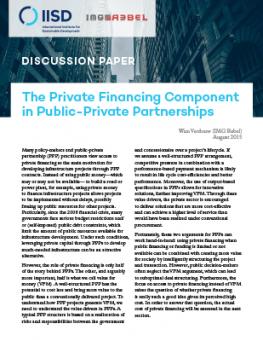
The Private Financing Component in Public-Private Partnerships
Many policy-makers and public-private partnership (PPP) practitioners view access to private financing as the main motivation for developing infrastructure projects through PPP contracts.
Instead of using public money—which may or may not be available— to build a road or power plant, for example, using private money to finance infrastructure projects allows projects to be implemented without delays, possibly freeing up public resources for other projects. Particularly, since the 2008 financial crisis, many governments face serious budget restrictions and/or (self-imposed) public debt constraints, which limit the amount of public resources available for infrastructure development. Under such conditions, leveraging private capital through PPPs to develop much-needed infrastructure can be an attractive alternative.
However, the role of private financing is only half of the story behind PPPs. The other, and arguably more important, half is what we call value for money (VFM). A well-structured PPP has the potential to cost less and bring more value to the public than a conventionally delivered project. To understand how PPP projects generate VFM, we need to understand the value drivers in PPPs.
This paper was funded by the Danish International Development Agency (DANIDA).
You might also be interested in
Monitoring Progress in Green Public Procurement
This report outlines the importance of monitoring progress in green public procurement (GPP) and highlights various methodologies, challenges, and recommendations.
Gender Equality at the Heart of Recovery: Advocating for Gender-Responsive Procurement in Ukraine
Ukraine is already preparing for reconstruction, which will cost an estimated USD 411 billion and take at least 10 years. The integration of gender considerations into public procurement processes could generate greater inclusivity in a rebuilt Ukraine.
A Sustainable Asset Valuation of Non-Motorized Transport in Coimbatore, India
A Sustainable Asset Valuation (SAVi) of the economic, social, and environmental benefits of a non-motorized transport (NMT) network in Coimbatore, India.
FAQ: Legal Considerations When Using the CO2 Performance Ladder in Public Procurement
This report answers frequently asked questions about the legal aspects of using the CO2 Performance Ladder as a green public procurement tool.